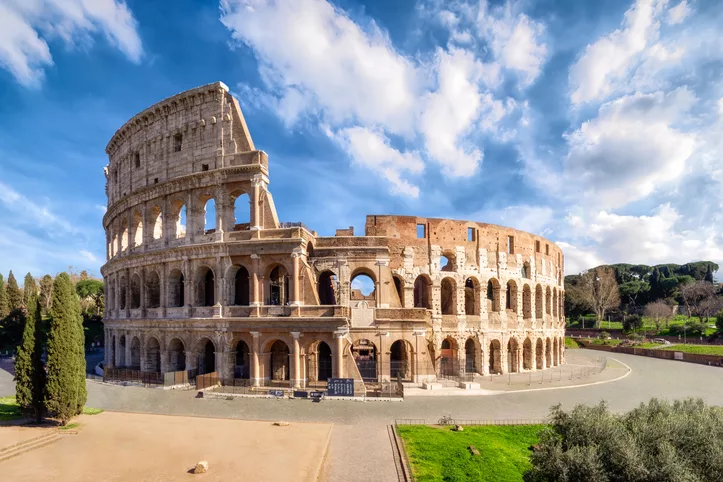The Colosseum also called the Flavian Amphitheatre, stands proudly as an oval amphitheatre at the heart of Rome, Italy. Crafted from a blend of concrete and sand, it holds the distinction of being the most colossal amphitheatre ever constructed. Situated just east of the Roman Forum, this monumental structure had its origins in AD 72 when Emperor Vespasian initiated its construction. Remarkably, it was completed in AD 80 under the reign of his successor and heir, Titus. Further refinements and enhancements were carried out during the reign of Domitian (81–96). This lineage of emperors, known as the Flavian dynasty, lent their name to this grand edifice in Latin (Flavius).

Colosseum in Rome without people in the morning, Italy. Picture: Getty Images
The Colosseum boasted a staggering capacity, accommodating an estimated 50 000 to 80 000 spectators, with an average attendance hovering around 65 000. It served as the arena for thrilling gladiatorial contests and extravagant public spectacles, including simulated naval battles (though this was short-lived, as the hypogeum was soon adapted for other purposes), wild animal hunts, executions, reenactments of historic battles, and dramas inspired by Classical mythology. However, with the onset of the early medieval era, its role shifted away from entertainment. Over time, it was repurposed for diverse functions, serving as housing, workshops, and lodgings for a religious order, a fortress, a quarry, and a Christian sanctuary.
Despite bearing the scars of earthquakes and facing depredations by stone thieves, the Colosseum endures as a timeless symbol of Imperial Rome. It ranks among Rome’s most sought-after tourist destinations and shares a connection with the Roman Catholic Church. Each Good Friday, the Pope leads a torchlit “Way of the Cross” procession commencing in the vicinity of the Colosseum.
Additionally, the Colosseum graces the Italian version of the five-cent euro coin.
Originally known as Amphitheatrum Flavium in Latin, a name often anglicized as Flavian Amphitheater, this architectural marvel emerged during the rule of emperors from the Flavian dynasty, succeeding the reign of Nero. Though this moniker remains in use in modern English, the edifice is more commonly recognized as the Colosseum. In antiquity, Romans may have occasionally referred to it as the unofficial Amphitheatrum Caesareum (with Caesareum functioning as an adjective linked to the title Caesar). However, this name likely had poetic overtones, as it was not exclusive to the Colosseum; Vespasian and Titus, the builders of the Colosseum, also erected an amphitheatre bearing the same name in Puteoli (modern-day Pozzuoli).
The etymology of the name “Colosseum” has long been linked to a colossal statue of Nero located nearby (the statue, in turn, was named after the Colossus of Rhodes). This statue underwent alterations under Nero’s successors, transforming into the likeness of Helios (Sol) or Apollo, the sun god, complete with an appropriate solar crown. Nero’s visage was replaced several times with those of subsequent emperors. Despite its pagan associations, the statue stood tall well into the medieval era and was attributed with mystical powers. It came to symbolize the enduring nature of Rome.
In the 8th century, a renowned epigram attributed to the Venerable Bede celebrated the statue’s symbolic significance in a prophecy that has been variously quoted: “Quamdiu stat Colisæus, stat et Roma; quando cadet colisæus, cadet et Roma; quando cadet Roma, cadet et mundus” (“as long as the Colossus stands, so shall Rome; when the Colossus falls, Rome shall fall; when Rome falls, so falls the world”). This prophecy is often misconstrued to refer to the Colosseum rather than the Colossus (as seen in Byron’s poem Childe Harold’s Pilgrimage). However, during the time Pseudo-Bede wrote, the masculine noun “coliseus” was associated with the statue rather than the still-known Flavian amphitheatre.
Eventually, the Colossus did indeed fall, possibly dismantled for its bronze. By the year 1000, the name “Colosseum” had evolved to refer to the amphitheatre itself. The statue faded into obscurity, with only its base surviving, nestled between the Colosseum and the nearby Temple of Venus and Roma.
Through the ages, the name further morphed into “Coliseum” during the Middle Ages. In Italy, it retains its identity as “il Colosseo,” while other Romance languages have adopted similar terms such as “Coloseumul” (Romanian), “le Colisée” (French), “el Coliseo” (Spanish), and “o Coliseu” (Portuguese).
Follow us on social media for more travel news, inspiration, and guides. You can also tag us to be featured.
TikTok | Instagram | Facebook | Twitter

















